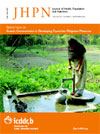
|
The Journal of Health, Population and Nutrition
icddr,b
ISSN: 1606-0997
EISSN: 1606-0997
Vol. 27, No. 6, 2009, pp. 711-724
|
 Bioline Code: hn09073
Bioline Code: hn09073
Full paper language: English
Document type: Research Article
Document available free of charge
|
|
|
The Journal of Health, Population and Nutrition, Vol. 27, No. 6, 2009, pp. 711-724
| en |
Evaluating Investments in Typhoid Vaccines in Two Slums in Kolkata, India
Cook, Joseph; Sur, Dipika; Clemens, John & Whittington, Dale
Abstract
New-generation vaccines against typhoid fever have the potential to reduce the burden of disease in areas
where the disease is endemic. The case for public expenditure on typhoid Vi polysaccharide vaccines for two
low-income, high-incidence slums (Narkeldanga and Tiljala) in Kolkata, India, was examined. Three measures
of the economic benefits of the vaccines were used: private and public cost-of-illness (COI) avoided;
avoided COI plus mortality risk-reduction benefits; and willingness-to-pay (WTP) derived from stated preference
(contingent valuation) studies conducted in Tiljala in 2004. Benefits and costs were examined from
a social perspective. The study represents a unique opportunity to evaluate typhoid-vaccine programmes
using a wealth of new site-specific epidemiological and economic data. Three typhoid-vaccination strategies
(targeting only enrolled school children, targeting all children, and targeting adults and children)
would most likely pass a social cost-benefit test, unless benefits are restricted to include only avoided COI.
All three strategies would be considered 'very cost-effective' using the standard comparisons of cost per
disability-adjusted life-year avoided with per-capita gross domestic product. However, at an average total
cost per immunized person of ~US$ 1.1, a typhoid-vaccination programme would absorb a sixth of existing
public-sector spending on health (on a per-capita basis) in India. Because there appears to be significant
private economic demand for typhoid vaccines, the Government could design a financially-sustainable
programme with user-fees. The results show that a programme where adults pay a higher fee to subsidize
vaccines for children (who have higher incidence) would avoid more cases than a uniform user-fee and still
achieve revenue-neutrality.
Keywords
Costs and cost analysis; Cost-benefit analysis; Evaluation studies; Slums; Typhoid; Typhoid vaccine; India
|
| |
© Copyright 2009 - International Centre For Diarrhoeal Disease Research, Bangladesh
Alternative site location: http://www.jhpn.net
|
|
